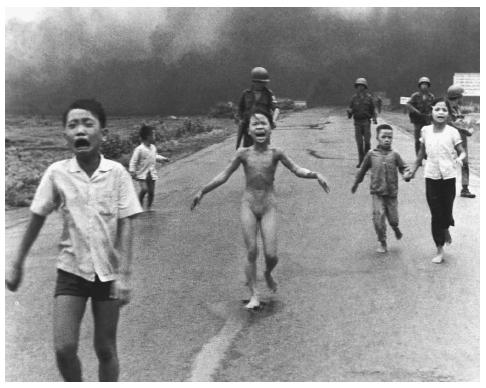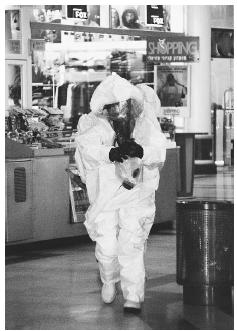Chemical Warfare
█ BRIAN HOYLE
Chemical warfare involves the aggressive use of bulk chemicals that cause death or grave injury. These chemicals are different from the lethal chemical compounds that are part of infectious bacteria or viruses. The latter constitute biological warfare.
History of Chemical Warfare
The use of chemicals in warfare began centuries ago, when early combatants learned that smoke from burning sulfur caused discomfort when it drifted into enemy fortifications. The dawn of modern chemical warfare occurred during World War I. On April 15, 1915, German forces released about 160 tons of chlorine gas into the wind near the Belgian village of Ypres. The clouds of the gas drifted into Allied forces, killing some 5,000 soldiers. Two days later, another chlorine attack at the same village killed 5,000 more soldiers.
During the remainder of World War I, German and British forces used chlorine gas, and other chemicals (i.e., mustard gas and phosphene) with increasing tendency. Estimates are that approximately 113,000 tons of chemical weapons were used from 1915 to 1918, killing some 92,000 people and injuring over one million people.
The aerial release of chemicals brought unpredictable results at the mercy of prevailing winds. Shifting winds could send the deadly cloud back to the attacking troops. Later during World War I, more sophisticated use of chemical weapons began. For example, the French used shells filled with an irritant to the eyes, skin, and lining of the nose and lungs, and the Germans fired lead balls coated with similar irritant.
The horrors of chemical warfare during World War I prompted the drafting of the Geneva Protocol of 1925, which banned chemical and biological weapons of warfare. The protocol was initially signed by 38 nations (now over 130 nations). As history has shown, the protocol has

not stopped the use of such weapons by rouge states or fringe elements in order to commit terrorism.
Aerial releases of lethal chemicals did not occur in World War II. However, the Germans developed a new class of chemical weapon called nerve agents. During the 1930s and 1940s, agents such as Tabun, Sarin, and Soman were created.
Chemical warfare research continued during the Cold War tensions during the 1950s. During this time, military chemists in the United Kingdom and then in the United States adapted insecticides to produce the most lethal chemical agent then known. The agent was code named VX. The potency of VX was accidentally demonstrated in 1968, when a testing accident at the VX manufacturing plant in Dugway, Utah killed over 6,000 sheep.
During the Vietnam War of the 1970s, the U.S. use of defoliants—chemicals that killed vegetation, permitting a clearer detection of the enemy—was extensive. One of these compounds, Agent Orange, has become infamous as the alleged cause of a variety of physical ailments in veterans of the conflict.
In the last few decades, chemicals have become the tools of terrorists. A particularly well-known example is the release of Sarin gas into the Tokyo subway system by the religious cult Aum Shinrikyo in March of 1995. The gas killed 12 people and injured over 5,500 people in 16 stations.
Chemical Warfare Agents
There are several classes of chemical warfare agents, based on their effects:
- compounds that cause choking or that irritate the lungs,
- blister agents (also called vesicants),
- blood agents,
- nerve agents,
- herbicides, and

- incendiaries
Choking and irritant agents. There are a number of compounds that cause choking or irritation of lung tissue. Examples include chlorine, phosgene (carbonyl chloride), diphosgene, chloropicrin, ethyldichloroarsine, and perflurorisobutylene.
Chlorine gas is suffocating and quickly burns tissues in the nose, mouth, and lungs. The burned tissue can die and slough off, causing lasting damage. Chlorine gas dissipates in the air very quickly. If exposure is not too long, than damage can be minor. In contrast, the compound called disphosgene is a liquid at room temperature, and so persists much longer.
Blister agents. As their name implies, blister agents cause the formation of large and painful blisters on the skin. Eye and lung tissue can also be damaged. A well-known example of a blistering agent dating from World War I is mustard gas. The damage to cells of the skin cause blistering up to 24 hours after exposure to mustard gas. These blisters take a long time to heal and can send the body into a lethal shock reaction.
Other examples of blistering agents include nitrogen mustard, lewisite, and phenyldichloroarsine. The latter compound is a liquid, which can be sprayed onto an enemy or released from a balloon, helicopter, or airplane.
Blood agents. These compounds interfere with the body's ability to transport oxygen in the bloodstream. This is done by either blocking the use of oxygen by cells in the body or by blocking the ability of the blood to take up the oxygen. Examples include hydrogen cyanide (also called prussic acid), cyanogen chloride, arsine, carbon monoxide, and hydrogen sulfide.
Hydrogen cyanide is initially a liquid at room temperature, but it quickly evaporates. This compound is noteworthy in recent world history, as it was used by Iraq in 1988 on an attack on the Kurdish town of Halabja during the Iran-Iraq war. Because of its past use by Iraq, hydrogen cyanide was one of the major concerns of United Nations inspectors who inspected various facilities in Iraq during the winter of 2003.
Compounds such as arsine and carbon monoxide destroy the ability of the hemoglobin component of the blood to bind oxygen. Arsine does this by destroying the red blood cells. Carbon monoxide binds to hemoglobin, blocking the binding of oxygen.
Nerve agents. Compounds that are classified as nerve agents interfere with the body's transmission of nerve impulses. This is done by disrupting the activity of a chemical called acetyl cholinesterase, which functions to bridge the gap between adjacent nerve cells, permitting an electrical nerve signal to pass from one nerve cell to the next.
Nerve agents were first developed in 1936, following the development of organophosphate types of pesticides. The first nerve agent that was made is called Tabrun. It is a member of what is known as the G series of nerve agents. Other G series members are Sarin and Soman. Sarin is particularly lethal; a small amount absorbed through the skin can kill a man within two minutes. When inhaled, death occurs within 15 minutes. Sarin is infamous as the gas released into the Tokyo subway system by the fringe group Aum Shinrikyo in 1995.
Another series of nerve agents are called the V series. Members of this series—which are commonly abbreviated according to their chemical composition—are more potent than the agents of the G series. As well, they persist longer in the environment. They can, for example, be applied to surfaces like roads as a slime.
Examples of V series agents include VX, VE, VG, and VM. VX is extremely potent; a drop of the liquid absorbed through the skin is lethal within a few hours without treatment.
Nerve agents can be contained in missiles or in canisters for lengthy time periods. Examination of caves in Afghanistan that were used as strongholds by the terrorist group al Qaeda has revealed evidence of stores of Sarin and VX.
Herbicides. Herbicides are chemicals that kill vegetation. Such chemicals are often used in everyday life to keep lawns free of weeds (although more environmentallyfriendly alternatives are becoming popular). When used in war, herbicides are weapons of mass destruction to foliage. Destruction of plants and the resulting loss of leaf cover remove much of the concealment for an enemy in a forested area. These philosophies led to the massive use of Agent Orange by the United States in the Vietnam War in the 1970s. Since that war, the damaging effects of herbicides like Agent Orange and paraquat on the human nervous and immune systems has become evident.
Incendiaries. Incendiaries are chemicals that cause fires. In warfare, they are also to remove vegetation. An infamous incendiary is napalm. Napalm is a mixture of naphthenic acid, coconut fatty acids, and palm oil. In addition to its highly flammable property, napalm absorbs into exposed skin, where it can cause severe burns if ignited. Napalm was used as an offensive weapon by the United States during the Vietnam War.
Modern Day Chemical Warfare
In 2003, the use of chemical weapons remains a threat from rogue states and terrorists. Current world attention is focused on the former chemical warfare capabilities of Iraq. It is known that Iraq engaged in chemical warfare research and weaponization in the 1980s and 1990s, and as of early 2003, before the U.S. war in Iraq, had not fully complied with United Nations resolutions requiring disclosure and destruction of their chemical weapons program.
█ FURTHER READING:
BOOKS:
Ellison, D. Hank. Handbook of Chemical and Biological Warfare Agents. Boca Raton: CRC Press, 1999.
Harris, Robert, and Jeremy Paxman. A Higher Form of Killing: The Secret History of Chemical and Biological Warfare. New York: Random House, 2002.
PERIODICALS:
Macintrye, A. G., C. G. W. Eitzen, Jr., R. Gum, et al. "Weapons of Mass Destruction Events with Contaminated Casualties: Effective Planning for Health Care Facilities." Journal of the American Medical Association no. 283 (2000): 252–253.
Munro, N.B., S.S. Talmage, G.D. Griffin, et al. "The Sources, Fate, and Toxicity of Chemical Warfare Agent Degradation Products." Environmental Health Perspectives no. 107 (1999): 933–974.
Nakajima, T., S. Ohta, Y. Fukushima, et al. "Sequelae of Sarin Toxicity at One and Three Years after Exposure in Matsumoto, Japan." Journal of Epidemiology no. 9 (1999): 337–343.
ELECTRONIC:
How Stuff Works. "How Biological and Chemical Warfare Works." 2002. < http://www.howstuffworks.com/Biochem-war.htm >(10 January 2003).
SEE ALSO
Chemical and Biological Detection Technologies
USAMRICD (United States Army Medical Research Institute of Chemical
Defense)
Comment about this article, ask questions, or add new information about this topic: